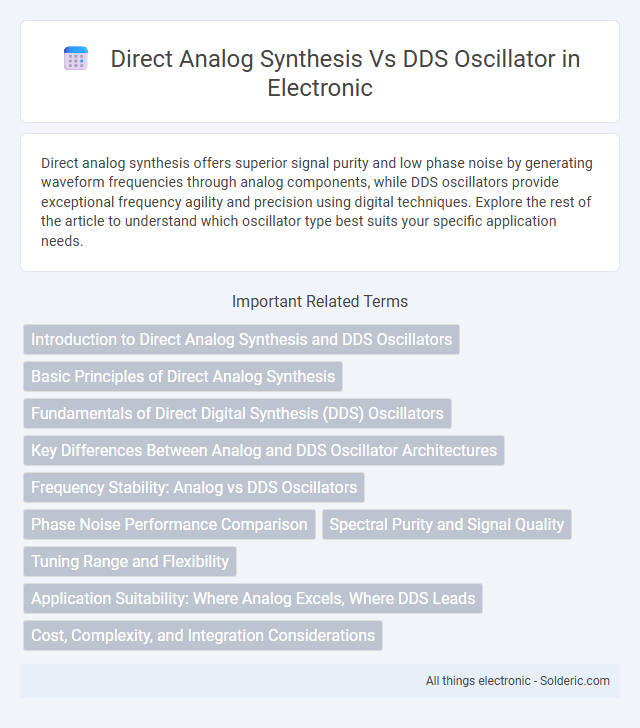Direct analog synthesis offers superior signal purity and low phase noise by generating waveform frequencies through analog components, while DDS oscillators provide exceptional frequency agility and precision using digital techniques. Explore the rest of the article to understand which oscillator type best suits your specific application needs.
Comparison Table
| Feature | Direct Analog Synthesis | Direct Digital Synthesis (DDS) Oscillator |
|---|---|---|
| Frequency Generation Method | Analog frequency mixing and filtering | Digital phase accumulator with DAC conversion |
| Tuning Resolution | Limited by analog components, coarse | High, controlled by digital word length (e.g., 32-bit) |
| Frequency Range | Depends on analog components and design | Wide frequency range within Nyquist limit of DAC |
| Spectral Purity | Potentially better with low noise analog circuits | Subject to spurious signals and quantization noise |
| Phase Noise | Low phase noise achievable with quality oscillators | Typically higher phase noise due to digital jitter |
| Complexity | Lower complexity, analog components based | Higher complexity, requires microcontroller/FPGA and DAC |
| Flexibility | Limited, changes require hardware adjustments | Highly flexible, programmable frequency and modulation |
| Cost | Generally lower for simple designs | Higher due to digital processing and DAC cost |
Introduction to Direct Analog Synthesis and DDS Oscillators
Direct Analog Synthesis generates waveforms by combining multiple analog signals through mixers and filters, enabling precise frequency control with low phase noise. DDS (Direct Digital Synthesis) oscillators utilize a digital phase accumulator and lookup tables to produce high-resolution frequency outputs with rapid frequency switching capabilities. Both methods offer unique advantages, with Direct Analog Synthesis excelling in signal purity and DDS providing digital flexibility and integration.
Basic Principles of Direct Analog Synthesis
Direct analog synthesis relies on generating signals through frequency mixing and filtering, combining multiple analog frequency sources to produce a desired output signal with high spectral purity. Unlike DDS oscillators, which use digital phase accumulation and DAC conversion, direct analog synthesis offers superior phase noise performance and spurious-free dynamic range. Your choice depends on application requirements such as signal quality and synthesis complexity.
Fundamentals of Direct Digital Synthesis (DDS) Oscillators
Direct Digital Synthesis (DDS) oscillators generate precise frequencies by using a phase accumulator and a digital-to-analog converter (DAC) to convert digital phase values into analog signals, enabling finely tunable frequency outputs with high stability. Unlike Direct Analog Synthesis, which relies on analog components like mixers and filters, DDS systems offer rapid frequency agility, minimal phase noise, and exceptional frequency resolution due to their digital control architecture. Your applications benefit from DDS technology in scenarios requiring agile signal generation, such as communication systems, signal modulation, and frequency hopping.
Key Differences Between Analog and DDS Oscillator Architectures
The key differences between direct analog synthesis and DDS (Direct Digital Synthesis) oscillator architectures lie in signal generation and frequency control methods. Analog oscillators rely on continuous electronic components such as LC circuits or crystal resonators for stable frequency output, whereas DDS oscillators use digital signal processing and numerically controlled oscillators to generate precise, programmable waveforms. DDS offers finer frequency resolution, rapid frequency switching, and enhanced spectral purity compared to traditional analog oscillators, making it ideal for applications requiring agile and accurate frequency synthesis.
Frequency Stability: Analog vs DDS Oscillators
Direct analog synthesis relies on high-quality analog components and temperature-compensated oscillators, providing excellent frequency stability in controlled environments. DDS oscillators offer superior frequency agility and fine resolution but may experience slight frequency instability due to clock jitter and phase noise inherent in digital circuits. Your choice depends on whether long-term frequency precision or rapid frequency tuning is more critical for your application.
Phase Noise Performance Comparison
Direct Analog Synthesis (DAS) typically exhibits lower phase noise compared to Direct Digital Synthesis (DDS) oscillators due to its purely analog signal generation process, which avoids the quantization noise inherent in digital systems. DDS oscillators tend to have higher phase noise, especially at close-in offsets, because of digital clock jitter and DAC aperture effects. For your applications requiring ultra-low phase noise, DAS is often the preferred choice, whereas DDS offers frequency agility with slightly compromised phase noise performance.
Spectral Purity and Signal Quality
Direct analog synthesis provides superior spectral purity and signal quality by generating waveforms through stable, low-noise components, minimizing phase noise and spurious harmonics. DDS oscillators offer fine frequency resolution and fast switching but often suffer from spurious signals, clock jitter, and quantization noise that degrade signal quality. Careful design of analog filtering and high-precision clock sources is essential in DDS systems to approach the spectral purity inherently achieved by direct analog synthesis.
Tuning Range and Flexibility
Direct analog synthesis offers a wide tuning range with continuous frequency adjustment, making it ideal for applications requiring smooth frequency sweeps. DDS oscillators provide exceptional frequency resolution and rapid switching capabilities within a limited tuning range, enhancing precision and flexibility for digital signal generation. Your choice depends on whether broad tuning range or fine frequency control is the priority in your system design.
Application Suitability: Where Analog Excels, Where DDS Leads
Direct analog synthesis excels in high-frequency, low-phase-noise applications such as RF signal generation and microwave communications, offering superior spectral purity and minimal jitter. DDS oscillators lead in flexibility and frequency agility, supporting rapid frequency hopping and complex modulation schemes ideal for software-defined radio and test instrumentation. The choice hinges on application-specific demands for spectral purity versus dynamic frequency control and configurability.
Cost, Complexity, and Integration Considerations
Direct analog synthesis generally offers lower cost and reduced complexity due to fewer digital components compared to DDS oscillators. DDS oscillators feature higher integration with digital control, enabling finer frequency resolution and programmability but at increased cost and design complexity. Integration considerations favor DDS in complex systems requiring precise frequency agility, while direct analog synthesis suits simpler, cost-sensitive applications.
Direct analog synthesis vs DDS oscillator Infographic

 solderic.com
solderic.com